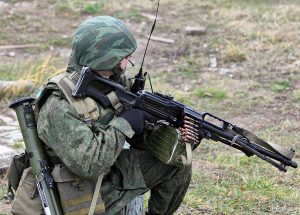US Army is very fond of using new terminologies. Remember LICO, SASO. MOOTW, Asymmetric, irregular, unconventional, long, small then came 4GW and now Hybrid. Add to it Chinese unrestricted warfare and our copy of Israeli sub conventional warfare.
What is wrong with good old CI Ops. Of course there will be different hues of it. J&K and NE and Punjab all will be different. It will change with time also.
Please tell me what do you call operations in J&K. Proxy, subconventional, 4GW, Hybrid or CI/CT Ops?
Let us not imitate Uncle Sam blindly. Please tell me when did they successfully fight a CI Ops. Granada?
There are not many success stories of fighting CI Ops. We in Indian Army can rightfully claim some notable victories like Punjab, Mizoram. Nagaland is under control. There are others which are kept under reasonable control. Which country can have such success stories.
Time to articulate out strategies, tactics, even jugad properly. This we singularly lack, our Cat A ests , ARTRAC, DGMT have failed miserably. Can you tell me what was the strategy adapted in Punjab, anywhere well articulated for future.
I am waiting when some smart alecs start propagating Gray Area Warfare in India which is being written about by US Army War Colleges or Multi Domain Battle propagated by US Army. It takes generally couple of years to imbibe these terminologies by us.
We must have respect on our own abilities, we must have our own terminologies, if we can articulate our strategy, tactics, techniques and procedures the whole world would come to us. Nobody has more success stories in CI Ops in this world than us. When Lt Gen Arjun Ray was thrusting down our throats SADBHAVNA many of us did not like. Later the yanks took a cue and said WHAM! Lo and behold we also started talking about WHAM. My contention is at least terminologies we use should be Make in India. If one wants to be called soldier scholar, I have no issue on that. But why copy yanks, coin an Indian term! West Point says : It's all about honoring the school's "soldier scholars."
The United States Army and West Point are indivisible. To separate the Army from West Point is to take away the purpose of the United States Military Academy. Since its founding in 1802, West Point has produced soldier scholars for America. The best education in the nation hones the intellect, while the tough physical and military training creates the warrior. The Army West Point primary mark perfectly portrays the soldier scholar ideal. Athena's helmet symbolizes wisdom while the sword represents the warrior ready for battle.
Here is my take on Hybrid Warfare.
HYBRID WARFARE – OLD WINE IN A NEW BOTTLE
- Maj Gen P K Mallick,VSM (Retd)
The concept of Hybrid Warfare is about decade old. A retd Lt Col Frank Hoffman from US Marine Corps floated this concept. One of those initial papers is available at : http://www.potomacinstitute.org/images/stories/publications/potomac_hybridwar_0108.pdf. The other papers were : Lt. Gen. James N. Mattis and Frank Hoffman, “Future Warfare: The Rise of Hybrid Warfare,” Naval Institute Proceedings, November 2005, pp. 30-32; Frank G. Hoffman, “How the Marines are Preparing for Hybrid Wars,” Armed Forces Journal, April 2006; Frank G. Hoffman “Preparing for Hybrid Wars,” Marine Corps Gazette, March 2007. Thisconcept came up after the 2006 summer conflict between Israel and Hezbollah. Since I was following this development those days I had kept 60 odd papers on Hybrid Warfare in my warfare page of Knowledge on Line available at : http://indianstrategicknowledgeonline.com/_viewresult_warfare.php?t=Hybrid%20Warfare
I had given three star rating to one of the 24 page presentations titled Irregular Warfare, COIN, Hybrid, Asymmetric Warfare, and "COIN next available at : http://indianstrategicknowledgeonline.com/web/DIRIWCSCBriefv3.pdf. Request read it.
Since those days Fourtg Generation Warfare was the toast of any discussion on counterinsurgency I flagged two more papers on the relationship between 4GW anf Hybrid warfare. You may like to read FROM FOURTH GENERATION WARFARE TO HYBRID WAR available at http://indianstrategicknowledgeonline.com/web/FROM%20FOURTH%20GENERATION%20to%20hybrid.pdf
I found an excellent paper on The real threat of hybrid conflict which was also put dutifully on my knowledge on line site available at : http://indianstrategicknowledgeonline.com/web/real-threat-of-hybrid-conflict.pdf. The author writes and I quote : The challenge of so-called hybrid war is that it's reminded us of the need to consider these two questions together: firepower and maneuver, attack and defense, target identification and force protection. Artillery and air power are used in close combination with ground forces to pin down the enemy, force him to keep his head down and allow friendly ground forces to maneuver on his position. But how to separate him from the population, to force him to come out and fight? Well-trained infantry must be capable of meeting the enemy in his sanctuaries – whether forests or mountains or urban areas – to identify, isolate, and fix him for destruction. These are the fundamentals of combined-arms land warfare, as useful for Americans in 2018 as for Germans in 1918.
I also recommend reading the following :
Confessions of a Hybrid Warfare Skeptic available at : http://smallwarsjournal.com/jrnl/art/confessions-of-a-hybrid-warfare-skeptic
Assessing Russian Hybrid Warfare: A Successful Tool for Limited War available at : http://smallwarsjournal.com/jrnl/art/assessing-russian-hybrid-warfare-a-successful-tool-for-limited-war
US Department of Defense (DOD) officials had discussed the need to counter the continuum of threats that U.S. forces could face from nonstate and state-sponsored adversaries, including computer network and satellite attacks; portable surface-to-air missiles; improvised explosive devices; information and media manipulation; and chemical, biological, radiological, nuclear, and high yield explosive devices. In light of references to “hybrid warfare” by senior military officials and possible implications it could have for DOD’s strategic planning, DOD requested US Government Accounting Office(GAO) to examine:
Whether DOD has defined hybrid warfare and how hybrid warfare differs from other types of warfare.
The extent to which DOD is considering the implications of hybrid warfare in its overarching strategic planning documents.
The GAO findings are: DOD has not officially defined hybrid warfare at this time and has no plans to do so because DOD does not consider it a new form of warfare. Rather, officials from OSD, the Joint Staff, the four military services, and U.S. Joint Forces Command told us that their use of the term hybrid warfare describes the increasing complexity of future conflicts as well as the nature of the threat. Moreover, the DOD organizations we met with differed on their descriptions of hybrid warfare. For example, according to Air Force officials, hybrid warfare is a potent, complex variation of irregular warfare. U.S. Special Operations Command officials, though, do not use the term hybrid warfare, stating that current doctrine on traditional and irregular warfare is sufficient to describe the current and future operational environment. Although hybrid warfare is not an official term, we found references to “hybrid” and hybrid-related concepts in some DOD strategic planning documents; however, “hybrid warfare” has not been incorporated into DOD doctrine. For example, according to OSD officials, hybrid was used in the 2010 Quadrennial Defense Review Report to draw attention to the increasing complexity of future conflicts and the need for adaptable, resilient U.S. forces, and not to introduce a new form of warfare. The military services and U.S. Joint Forces Command also use the term “hybrid” in some of their strategic planning documents to articulate how each is addressing current and future threats, such as the cyber threat; however, the term full spectrum often is used in addition to or in lieu of hybrid. DOD concurred with the report. You may read the report at : http://www.gao.gov/assets/100/97053.pdf. I thought this should bury the debate.
Same thing happened with 4GW. I do not find much reference to 4GW in official documents of DOD or the Armed Forces.
Since the beginning of the Russian operation in Crimea in 2014, Hybrid warfare became a buzzword used in all transatlantic security policy circles. For many in the West, the Crimea operation came as a surprise and the term “hybrid warfare” was meant to intellectually embrace this shock. I recommend the following papers :
Nothing 'Hybrid' About Russia's War in Ukraine available at https://themoscowtimes.com/articles/nothing-hybrid-about-russias-war-in-ukraine-46913
HYBRID WARFARE: WHERE’S THE BEEF? AVAILABLE AT : HTTP://WARONTHEROCKS.COM/2015/04/HYBRID-WARFARE-WHERES-THE-BEEF/
Hybrid Warfare: A Known Unknown? available at : http://foreignpolicyblogs.com/2016/07/18/hybrid-warfare-known-unknown/
A google search on Hybrid Warfare published in last one year shows only Russian references! https://www.google.co.in/search?hl=en&as_q=hybrid+warfare&as_epq=&as_oq=&as_eq=&as_nlo=&as_nhi=&lr=&cr=&as_qdr=y&as_sitesearch=&as_occt=any&safe=images&as_filetype=pdf&as_rights=
I would go by a recent paper on the topic by NATO, Hybrid war – does it even exist? available at :
Where it states :
At a recent event sponsored by NATO and organized by the Atlantic Council, attendees were told that “there is no agreed definition of terms related to hybrid warfare.” In other words, the 28 members of the North Atlantic Alliance cannot agree on a clear definition of what they are facing. How can NATO leaders expect to develop an effective military strategy if they cannot define what they believe is the threat of the day?
So my recommendation is that NATO, and other Western decision-makers, should forget about everything “hybrid” and focus on the specificity and the interconnectedness of the threats they face. Warfare, whether it be ancient or modern, hybrid or not, is always complex and can hardly be subsumed into a single adjective. Any effective strategy should take this complex environment into account and find ways to navigate it without oversimplifying.
In 2009 CLAWS organised an international seminar on insurgency or terrorism I don't exactly remeber. Lt Col Thomas X. Hammes, again of US Marine Corps who had been writing extensively on 4GW and authored a much talked about book The Sling and the Stone: On War in the 21st Century came to deliver a talk. I asked him the same question, why is US Armed Forces reinventing the wheel. What is wrong with good old Counter Insurgency Operations. He was candid enough to reply that after the first gulf war, everybody was gaga about technology. RMA, System of Systems and all that. The very important aspect of counterinsurgency were being forgotten. They had to find a sexy terminology. He agreed essentially there is not much difference. Lt Gen Rostum Nanavatty who was chairing a session, in his own inimitable, soft, measured, crisp tone echoed the same sentiment of mine, I thought.
I can bet on one thing. Within a couple of years CLAWS will organise a seminar on Grey Zone Warfare and Multi Domain Battle. Please read the following papers : http://www.strategicstudiesinstitute.army.mil/pdffiles/PUB1303.pdf




